
I'm finally back in the
Queen City of the South after an afternoon spent in the southern half of
Cebu Island. I left Manila at 7:30 a.m. via Philippine Airlines and arrived in Mactan about an hour and a half later. It's great looking down on a clear day since you see the very same attractions from a different view. When flying south, you can't miss Mount Makiling, Taal Lake and its volcano, the seven lakes of San Pablo and Mount Banahaw from the sky which you see in the photo.
My brod Ryan Caparas met up with me at the airport but since he had work today, I told him to drop me off at the South Bus Terminal so that I could spend the day following the Southern Heritage Trail. I decided to start at the southernmost town on the trail,
Oslob, and work my way northwards back to Cebu City.
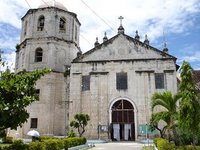
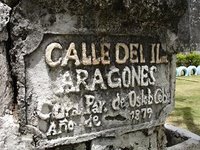
The trip was three hours so I took an air-conditioned bus so that it would be a comfortable ride. The fare was PHP108. I was asleep for most of the first part, obviously tired from driving the past few days, as well as from lack of sleep. But later on, I tried to keep myself awake or else I would miss one of the best coastline sceneries in the country. In fact, the entire national highway hugs the shoreline and you are offered spectacular views of white sand beaches and mangrove forests along the way.
I arrived in Oslob at about 12 noon and went straight to the church. Wow! The Immaculate Conception Church was a magnificent coral and limestone structure with ruins of some Spanish period government building at the side. After some photos, it was time for lunch. And like a true backpacker, I went for one of the
carinderias (canteens) near the bus stop. An
ulam (viand) and a heaping cup of rice costed me only PHP25.


It was off to the next town for me,
Boljoon, home of the Church of the Patrocinio de Maria, declared by the National Museum as a
national cultural treasure and by the National Historical Institute as a
national historical landmark. The fare from Oslob on an ordinary bus was P11. Between Oslob and Boljoon were several
watchtowers which are featured in Fr. Rene Javellana's book
Fortress of Empire.
The setting of the church was stunning, an open view of the white sand beach and blue waters in front, and hills towering at the back. The roof of the church and convent are still the original clay tiles from the Spanish period.
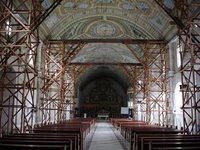

When I entered, just like in Masinloc, there was ongoing restoration work. Again, good news for heritage. The
convento was also very much intact. Thumbs up to the
Boljoon Heritage Foundation!
I strongly believe this church should be included in the Baroque Churches of the Philippines UNESCO listing if ever it is expanded. Or better yet, create a new listing incorporating the best of southern Cebu's coral and limestone churches!
Just when I thought Cebu was doing everything right for church heritage, there was
Argao. The fare to the place was P30. When I got there, I was impressed that the local government was blending the architecture of the new buildings with that of the old. The St. Michael the Archangel Church itself could have, on its own, been declared a World Heritage Site had it not been touched.
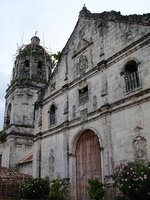
I was excited to enter since I've seen pictures of the interior in books. And did I get the shock of my life! The parish priest had converted the ornate polychrome rococo
retablo into the country's biggest trophy case! Yes folks! He had the
retablo painted gold and silver! The
santos are all painted gold! What is wrong with our priests?! Don't they have anything better to do? People like him should be transferred to Siberia where they won't do any more damage to Philippine church heritage. But I guess that is a tall order because rumor has it that this monsignor is very close to the cardinal.
To let you know the sentiments of the heritage community, here is the
column of Bambi Harper in the Philippine Daily Inquirer on the sacrilege committed. The entry is aptly entitled
A Crying Shame. In another of her
columns lauding Albay, Bambi writes, "Bishop Jose C. Sorra (of Albay) gave an impassioned and stirring address that the Cebu cardinal should have heard so that the parish priest of Argao, guilty of erasing 200 years of history, could be exiled to Burias or perhaps to the Marianas, which unfortunately doesn't belong to us anymore."
 I was off to a very popular heritage town of the province of Cebu, Carcar
I was off to a very popular heritage town of the province of Cebu, Carcar! Fare from Argao to Carcar was PHP20. The first landmark you will see is that heritage gazeebo at the center of a rotunda in front of the market. That is where I got off to take some photos.
Carcar is also known for its
chicharon (pork skin crackers) and
lechon (roasted pig). So how could I resist even a small pack of
chicharon for a snack! Yummy! Anyway, I'll talk more about Carcar in a future entry.
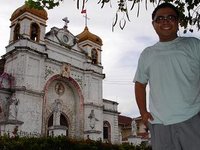
The Church of St. Catherine of Alexandria was just a short walk up a hill in the center of town. Indeed, the church and the structures around its plaza are splendid! While in Carcar, I visited the Noel Ancestral House owned by the family of Jerry N. Alfafara, a member of the Carcar Heritage Conservation Society. He gave me a tour around his house.

The last stop for the afternoon was
Naga which had a very ornate facade. It seemed to have Moorish influences as seen from the elements of the design. From Carcar, the fare was PHP15. With that settled, it was back to Cebu City. Fare from Naga was PHP20.
If only I had my own vehicle, I would have wanted to stop to take photos of all the
Gabaldon schoolhouses. In each town, I would believe there were at least three! But that is one of the limitations of backpacking. You have to travel within a tight budget.

Back in Cebu, I met up with Ryan near the bus station and we went to a well-known street food area of Cebu City called Larsian. Why it's called Larsian, I don't know since I tried asking the locals myself. The place is right beside the Osmena Circle (It's actually one of the side streets).

They serve various
ihaw-ihaw (roasted) items such as chicken and pork barbeque,
longganiza (local sausage), hotdogs,
isaw manok (chicken intestines), etc. The rice was also unique since it was served in what seemed to be woven coconut leaf-containers just like
suman (rice cake). The meal was not bad at all!
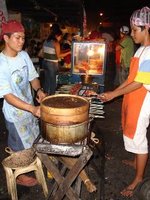
After Larsian, we looked for a place for me to stay for the night. One of the cheaper pension houses was fully-booked. I fear that since it is peak season, when I go to Bohol tomorrow, I might find it difficult to get lodging as well. Anyway, right now, I'll get some rest since I'm waking up early to visit the heritage area of Cebu City. Then I'll most probably leave for Bohol by lunch. That's it for now.
Related articlesBantayan Island, Cebu is rich in heritage and great beaches!Visita iglesia in Northern CebuLechon, chicharon and more from CarcarVisita iglesia in Southern Cebu






























 I was off to a very popular heritage town of the province of Cebu,
I was off to a very popular heritage town of the province of Cebu, 



